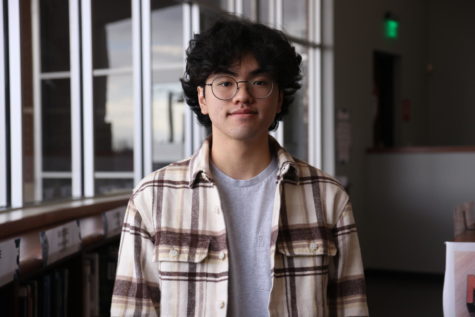The real effect of the teacher shortage

Chemistry teacher Rachmad Tjachyadi’s third period class practices solution acids and bases as they begin to conclude unit nine on May 17. Due to the ongoing teacher shortage Tjachyadi now has to teach five classes.
For the past decade, the U.S. has suffered from a massive teacher shortage. However, in the past two school years, this issue has become more evident in the community.
A high school the size of Hebron, with around 250 employees, will lose around 10% of its employees each year on average due to retirees, promotions or people moving out of the district. However, after COVID-19, schools saw an upsurge in teachers leaving. Before the pandemic, Hebron lost an average of around 17-19 teachers per year. In the 2020-2021 school year, the school lost 56 teachers. Principal Amy Boughton said this is not only from being overworked, but also from being underappreciated by the community.
“You’ve got to have tough skin to be a teacher,” Boughton said. “High school [students] are moody, [they’re] figuring themselves out, [and] teachers have to negotiate 30 people’s good and bad days — that’s already a lot. Then, all of the grading, requirements and training. If you’re not held in regard in the community or with society, it’s kind of like, ‘Yeah, I don’t need to take this.’ I hear that phrase more now than I ever have: just teachers angry because of the perception by some people out there.”
As of last year, schools across America are paid on average around $15,120 per pupil, covering only 7.9% of funding for public K-12 schools. This has led to LISD superintendent Dr. Lori Rapp, along with a few teachers, speaking to Congress in Austin about a need for more funding towards our district. In Texas, districts are paid $6,000 per student, which Boughton said isn’t enough.
“With just basic inflation every year, that dollar amount should be a lot higher than it is,” Boughton said. “Because you have gas prices going up with busing [and] you have teacher raises that need to happen in order to stay competitive. All of those things are going up, but the amount the state gives us per pupil has stayed the same. And so, that creates this funding crisis that everyone is talking about.”
With teachers retiring early, moving on to other fields and exploring other options, it leaves a gap for schools to fill. Teachers are required to make a decision on whether or not they want to retire by June 26, and if they leave the school later, they risk the consequence of having their teacher’s certificate sanctioned by the state. They also are at risk of creating a discomfort in the community, as the school has to scramble for a replacement, sometimes being left with the scarce resources they have.
Chemistry teacher, Rachmad Tjachyadi, has been covering a former chemistry teacher’s classes since April 3. Tjachyadi has been tasked with not only teaching two additional classes, but also taking on the paperwork that comes with it. It’s required by the state that teachers only teach three out of four periods, using that extra period as a time for planning and conference. This has indirectly helped with lessening teacher burnout, but Tjachyadi chose to teach all four periods to keep his students happy and in a stable learning environment, leaving him no time to re-gather himself besides lunch.
“It is taking a toll on me in a sense that I am more tired,” Tjachyadi said. “That’s the reason why we only teach three out of four classes, because I can tell by the fourth period, my stamina of redirecting the students has lessened because I’m tired. It’s adding 30% extra work to my day, [and] adding that extra work has taken a toll on my physical and mental [health.]”
In most corporate jobs, when a worker takes overtime, they are paid 1.5 times their salary. Tjachyadi is paid half, giving him a total of around $54 for taking over the additional classes, when he could be paid $69. Though it is only a $15 difference, this pay not only covers Tjachyadi’s additional time teaching, but also the paperwork that comes with it, which, in April included a multitude of AP Chemistry practice tests that held seven FRQs per student.
“A lot of people, if they have a choice, would not be working in this job,” Tjachyadi said. “I think society doesn’t realize that somebody that has been teaching for many years has expertise. Like a first year doctor versus a 20 year doctor, they don’t get paid the same amount of money and if somebody is going to operate on you, you want somebody who has a lot of experience. But, [that is] not in the case of teaching.”
This issue also occurred last school year when former math teacher Mark Axelson was given the position of computer science teacher in the beginning of the second semester. He was given a course guide in order to become more accustomed to the role while also having to obtain his teaching certificate for computer science.
“If you have a shortage of teachers, you’re going to have bigger classes,” Axelson said. “I do one-on-one work all day long with the students. [But] if it’s a bigger class, I don’t get to see [them]. The students [don’t] get as much help, which of course makes a huge difference, because some of these algorithms are not trivial.”
In recent years, the perception of teachers has changed within the United States, as the topic has become more political. Arguments on whether teachers should mention race or sexuality in their studies have become a point of tension, an example being a teacher under investigation in Florida for showing a Disney movie that had a clip involving LGBTQ+ topics to her class.
“I think the political landscape has hurt our profession a lot,” Boughton said. “If you look at some of the most successful countries, every year, they have teachers going into the profession and it’s just constantly rebuilding. There is a high regard for [teachers.] Let’s face it, no one wants to pour their heart and soul into a job every day and be ridiculed and be told, ‘you’re teaching kids things that you shouldn’t teach them’ and ‘you’re indoctrinating kids on this topic or that topic.’ That assault on public education has driven people away [from teaching].”
Across the United States, the college enrollment for students trying to become teachers has decreased in the past decade. Boughton said this is because of the large price that comes with getting a college education, yet a lack of a solid foundation to counter those costs and live a sustainable lifestyle.
“I think we have to come up with creative pathways if [applicants] don’t have the money to pay it up front,” Boughton said. “I mean, I really think you’ve got to start back at getting out in front of it with college students and high school students. We’ve got programs like PALS and we have a principles of education class here, you’ve got to start drumming up interest again. Then, if we can partner with a university [so that] you’re not spending $100,000 to go to college. We’ve got to find some creative ways, or else I’m really concerned that we’re not gonna be able to fill classrooms with highly qualified teachers.”
Recently, there was an email sent out to teachers in Texas that the average salary would be increased for both newer teachers and those who had been working in the field for a longer time. A new teacher will make $60,500 a year; however, a teacher who may have been working for 10-20 years will only make $6,000 more. Issues like this have caused teachers to flock toward more lucrative careers. Boughton said that, regardless of that fact, she still recognizes teachers putting in their all.
“I walk around and I see [teachers] going above and beyond; getting here early, staying late and doing whatever they can to reach each student they have or even somebody else’s student,” Boughton said. “From an administrative standpoint,… it really starts with the hiring of great people and great teachers, and then the student learning and everything else takes care of itself. I would say that I am really grateful for the teachers here. I couldn’t do my job at all, if it wasn’t for them and their support.”

Senior Nyla Smith is the news editor and this is her third year on staff. In her free time, she enjoys knitting and watching movies.

Senior Henry Pham is the visuals editor and this is his second year on staff. He spends a lot of time gaming, munching on food, listening to jazz music...


